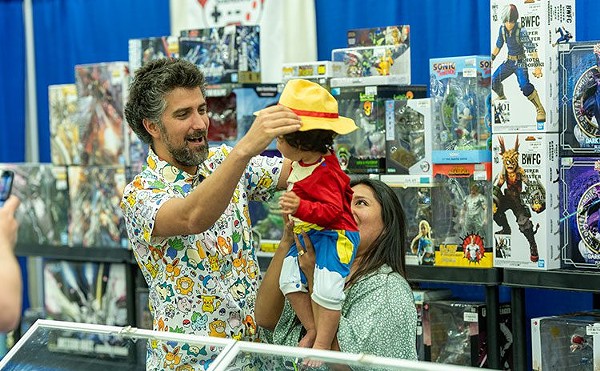For two hours every Friday, the Park Hill Community Center features a video game night that starts right after the school bell rings at 3 p.m. In lieu of tutoring, students can sharpen the skills that seem to matter most in the midst of one’s blossoming youth: hand-eye coordination.
In community centers across the city, the after-school programs afforded to K-12 students are in short supply, according to Councilman David James, D-6. “We have a lot of activities in our community centers, but I don’t know if we have a lot of programming in our community centers.”
James says Louisville’s 12 community centers (three of which — California, Park Hill, and South Louisville — are in his district) are largely underutilized, and he would like to see more programs centered around education and athletics.
Of particular interest to James and other city officials is the potential those centers hold to mitigate juvenile delinquency and, according to the Louisville Violence Prevention Workgroup’s Oct. 12, 2012, report, their potential to curb street violence.
“Build/enhance deep and durable connections between community centers and the schools relative to violence prevention/intervention and interrupter initiatives,” the report dryly suggests. “Connecting and leveraging existing community-based organizations with JCPS could ensure sustainable implementation of this recommendation.”
In other words, the task force recognized the role the city’s publicly funded community centers could play in preventing the kind of violence that rocked the city last May, when three people were shot to death in a two-hour spree that injured another three people and spurred city officials to ostensibly address the root causes of the violence.
As an example of the kind of programming he’d like to see, James cites a program in the California Community Center in which the Boy Scouts of America has partnered with JCPS to provide two teachers for after-school education four days a week.
“Those are the kind of things I think are really beneficial,” James says. “The great equalizer in the world is education. So if we can take these kids and provide them better education, better opportunities, then they’re going to do great things. It takes them from being in that … time after school when, oftentimes, kids find themselves in places doing things they shouldn’t be doing.”
It’s a more subtle approach to violence in west Louisville, one that stands in stark contrast to higher-profile methods: From Mayor Greg Fischer hiring Anthony Smith in the new position of director of Safe Neighborhoods, to Councilman James spending $11,000 in neighborhood discretionary funds to cover police overtime for increased officer presence in Victory Park.
Indeed, for all the anti-violence jeremiads levied by neighborhood leaders, preachers and politicians in the wake of the May 2012 shootings, tangible progress for implementing the community center strategy has been slow compared to other methods.
In April, the city hired Ben Johnson, formerly of Metro’s Office of Youth Development, to oversee community centers as assistant director for recreation — a position he says went unfilled for seven years.
Despite the lack of fanfare surrounding Johnson’s hiring, his immediate goal has been to bolster programming along the lines of the aforementioned California Community Center after-school workshops, as well as continued development of athletic programs and to aid the partnership between Metro Government, JCPS and Metro United Way called “Out of School Time,” a Community Development Block Grant-funded initiative to reduce the dropout rate by focusing on after-school education.
“Honestly, I think (the centers) are being totally underutilized,” Johnson says. “In the neighborhoods where they sit, a lot of time there aren’t a lot of other options, (the people) are landlocked or what have you. We have a great potential to do a whole lot more than what we’re doing.”
Johnson believes the biggest impediments are a lack of adequate funding as well as a perception that community centers aren’t capable of providing transformative change other than sharpening your pinochle skills. By leveraging the brick-and-mortar facilities, Johnson says the centers could be attractive to volunteers, groups and nonprofits without a roof of their own.
“We have to be a little more creative in how we do things,” he says. “We have to be more creative in our outreach.”
With Metro Council slated to pass a revised version of Mayor Fischer’s proposed 2013-2014 budget by the end of this month, the spending priorities of a resource-taxed government likely won’t include a massive bump for increased programming.
Of the $528 million in proposed general funds, only $2.48 million has been allotted to community and recreation centers — a modest $65,500 increase over last year. Combined with the effects of the federal budget sequestration, which have slashed funding for 500 low-income Kentucky children in need of after-school child care and reduced funding for after-school programs overall, it’s not a surprise that the city is looking toward public-private partnerships to augment community center offerings.
Sadiqa Reynolds, the city’s multi-tasked chief of community building, says she cannot stress enough the importance of such partnerships given the fiscal and political realities, and she heralds Johnson’s hiring as a sign that the administration is focused on improving centers. A self-described “community center kid,” Reynolds says this issue is “very personal” for her. She recalls the success story of Tretez Kinnaird, a Butler High School senior who attributes his Indiana University track scholarship to his exposure to the sport through the Southwick Community Center on Southern Avenue.
But, she realizes, there’s much progress to be made in order to replicate that kind of success. “I’m not suggesting we are where we want to be, but at the same time … there are people who have been working hard (at the centers) and trying to make a difference, but maybe sometimes not with all of the support they needed.” That said, Reynolds is confident the city is poised to gain traction on what she hopes is a revitalization of centers despite inadequate funding.
And the stakes are high. Ben Johnson believes that simply getting kids into the centers won’t address the bigger picture: providing them with a future.
“There used to be a train of thought of, ‘Hey, if they’re in my building then that’s better than them being on the street,’” he says. “That’s good, but nowadays, it’s not enough. We have to really be working to make these kids healthy, to be happy, to be successful, to be educated.”





